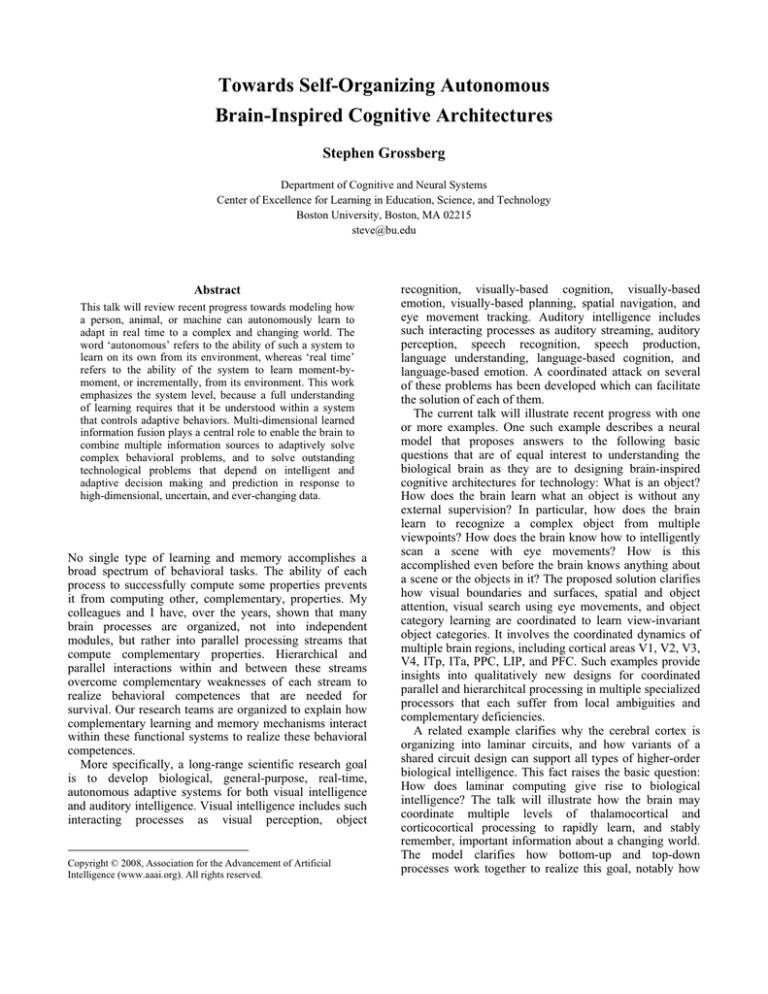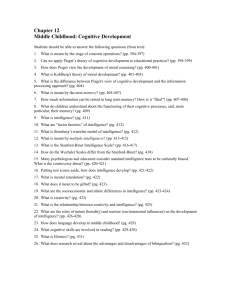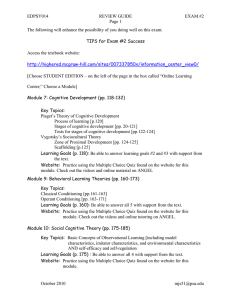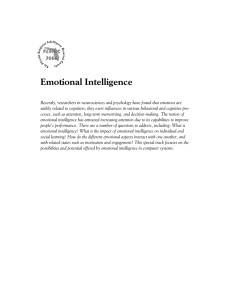
Towards Self-Organizing Autonomous
Brain-Inspired Cognitive Architectures
Stephen Grossberg
Department of Cognitive and Neural Systems
Center of Excellence for Learning in Education, Science, and Technology
Boston University, Boston, MA 02215
steve@bu.edu
Abstract
This talk will review recent progress towards modeling how
a person, animal, or machine can autonomously learn to
adapt in real time to a complex and changing world. The
word ‘autonomous’ refers to the ability of such a system to
learn on its own from its environment, whereas ‘real time’
refers to the ability of the system to learn moment-bymoment, or incrementally, from its environment. This work
emphasizes the system level, because a full understanding
of learning requires that it be understood within a system
that controls adaptive behaviors. Multi-dimensional learned
information fusion plays a central role to enable the brain to
combine multiple information sources to adaptively solve
complex behavioral problems, and to solve outstanding
technological problems that depend on intelligent and
adaptive decision making and prediction in response to
high-dimensional, uncertain, and ever-changing data.
No single type of learning and memory accomplishes a
broad spectrum of behavioral tasks. The ability of each
process to successfully compute some properties prevents
it from computing other, complementary, properties. My
colleagues and I have, over the years, shown that many
brain processes are organized, not into independent
modules, but rather into parallel processing streams that
compute complementary properties. Hierarchical and
parallel interactions within and between these streams
overcome complementary weaknesses of each stream to
realize behavioral competences that are needed for
survival. Our research teams are organized to explain how
complementary learning and memory mechanisms interact
within these functional systems to realize these behavioral
competences.
More specifically, a long-range scientific research goal
is to develop biological, general-purpose, real-time,
autonomous adaptive systems for both visual intelligence
and auditory intelligence. Visual intelligence includes such
interacting processes as visual perception, object
Copyright © 2008, Association for the Advancement of Artificial
Intelligence (www.aaai.org). All rights reserved.
recognition, visually-based cognition, visually-based
emotion, visually-based planning, spatial navigation, and
eye movement tracking. Auditory intelligence includes
such interacting processes as auditory streaming, auditory
perception, speech recognition, speech production,
language understanding, language-based cognition, and
language-based emotion. A coordinated attack on several
of these problems has been developed which can facilitate
the solution of each of them.
The current talk will illustrate recent progress with one
or more examples. One such example describes a neural
model that proposes answers to the following basic
questions that are of equal interest to understanding the
biological brain as they are to designing brain-inspired
cognitive architectures for technology: What is an object?
How does the brain learn what an object is without any
external supervision? In particular, how does the brain
learn to recognize a complex object from multiple
viewpoints? How does the brain know how to intelligently
scan a scene with eye movements? How is this
accomplished even before the brain knows anything about
a scene or the objects in it? The proposed solution clarifies
how visual boundaries and surfaces, spatial and object
attention, visual search using eye movements, and object
category learning are coordinated to learn view-invariant
object categories. It involves the coordinated dynamics of
multiple brain regions, including cortical areas V1, V2, V3,
V4, ITp, ITa, PPC, LIP, and PFC. Such examples provide
insights into qualitatively new designs for coordinated
parallel and hierarchitcal processing in multiple specialized
processors that each suffer from local ambiguities and
complementary deficiencies.
A related example clarifies why the cerebral cortex is
organizing into laminar circuits, and how variants of a
shared circuit design can support all types of higher-order
biological intelligence. This fact raises the basic question:
How does laminar computing give rise to biological
intelligence? The talk will illustrate how the brain may
coordinate multiple levels of thalamocortical and
corticocortical processing to rapidly learn, and stably
remember, important information about a changing world.
The model clarifies how bottom-up and top-down
processes work together to realize this goal, notably how
processes of learning, expectation, attention, resonance,
and synchrony are coordinated. The model hereby clarifies,
for the first time, how the following levels of brain
organization coexist to realize cognitive processing
properties that regulate fast learning and stable memory of
brain representations: single cell properties, such as spiking
dynamics, spike-timing-dependent plasticity (STDP), and
acetylcholine modulation; detailed laminar thalamic and
cortical circuit designs and their interactions; aggregate
cell recordings, such as current-source densities and local
field potentials; and single cell and large-scale inter-areal
oscillations in the gamma and beta frequency domains. In
particular, the model predicts how laminar circuits of
multiple cortical areas interact with primary and higherorder specific thalamic nuclei and nonspecific thalamic
nuclei to carry out attentive visual learning and information
processing. Variants of such laminar circuit models have
been used to provide unified explanations and predictions
of behavioral and neurobiological data about vision and
cognitive information processing.
Such examples of Complementary Computing and
Laminar Computing show that understanding the brain, as
well as brain-inspired cognitive architectures, requires the
introduction of new computing paradigms that represent a
radical break with traditional approaches to artificial
intelligence.
References
Fazl, A., Grossberg, S., & Mingolla, E. (2008). Viewinvariant object category learning, recognition, and search:
How spatial and object attention are coordinated using
surface-based attentional shrouds. Cognitive Psychology,
in press.
Gnadt, W. and Grossberg, S. (2008) SOVEREIGN: An
autonomous neural system for incrementally learning
planned action sequences to navigate towards a rewarded
goal. Neural Networks, in press.
Grossberg, S. and Huang, T.-R. (2008). ARTSCENE: A
neural system for natural scene classification. Journal of
Vision, in press.
Grossberg, S. and Pearson, L. (2008). Laminar cortical
dynamics of cognitive and motor working memory,
sequence learning and performance: Toward a unified
theory of how the cerebral cortex works. Psychological
Review, in press.
Grossberg, S. and Versace, M. (2008). Spikes, synchrony,
and attentive learning by laminar thalamocortical circuits.
Brain Research, in press.




